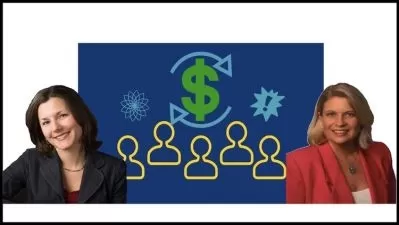Advanced Investments
Steve L. Slezak
12:45:52
Description
You’ve worked hard. You’ve saved. You’ve put your savings to work so that it will increase in value over time. In other words, you’ve invested. But are you earning the best return on your investments? Are you meeting your goals? Are you comfortable with your level of risk? How liquid are your investments?
Investing can be a valuable part of being able to achieve your hopes and dreams. It can help build a secure retirement. It can contribute toward paying for the education of your children and grandchildren. Income from your investments can help you build a legacy for family members or to support a cause you hold dear. In short, your investment decisions are some of the most important choices you make. Shouldn’t these be educated choices, supported by the best information, reasoning, and analytical techniques?
Whether you are starting out in your career, in your prime earning years, or retired, it is essential that you understand your investment choices in great detail—something that is not easy amid the flood of sure-fire strategies offered by books, television programs, online brokers, and professional wealth managers.
Consider the following decisions that face any investor in the market:
- Active or passive? An active investing strategy takes advantage of mispriced securities that can be traded for a profit. A passive approach seeks to build a well-diversified portfolio that can be put on automatic pilot. Many investors combine these strategies.
- What kind of securities? Securities are tradable assets, notably stocks and bonds. But they also include derivatives such as options, which are useful for hedging against losses. All securities are tools that work well under certain circumstances but not others.
- Can you spot opportunities? How do you distinguish an opportunity from a pitfall? It’s crucial to know the most common mistakes that investors make and be familiar with the analytical tools that allow you to gauge a potential opening for financial gain.
- Can you manage risk? Risk may be the most misunderstood factor in investing. Contrary to much financial advice, increasing your chance of success does not require increased risk. However, it does require measuring and managing risk effectively.
Advanced Investments puts you on the road to a thorough grasp of cutting-edge investment principles and practices, presented in 24 informative lectures by Professor Steve L. Slezak of the University of Cincinnati. Professor Slezak is Director of the university’s Carl H. Lindner III Center for Insurance and Risk Management, and the winner of multiple teaching awards for the clarity, excitement, and rigor of his instruction.
Master the Art of Investing
In Advanced Investments, you learn practical techniques for analyzing the central problem of investing: how to determine if a potential investment is a good deal. Using concepts from probability and statistics, you learn how to measure risk accurately. Then you explore methods for determining if a security will generate returns that compensate for its risk. Throughout the course, you constantly weigh the relative advantages of active and passive strategies, gaining an appreciation for how you can take active and passive positions in different securities.
Professor Slezak carefully explains the mathematics as he walks you through a rich range of problems and examples. You need not work out the solutions yourself, but it is vital that you have an intuitive grasp of how investors use formulas. You will learn the financial meaning of terms such as expected value, variance, covariance, and standard deviation. Unlike most other investment courses, Advanced Investments immerses you in the actual technical vocabulary and procedures used by professionals.
The video versions of the course have dozens of charts, diagrams, and on-screen equations that help you follow Professor Slezak’s many case studies and sample problems. The guidebook that accompanies the course also includes these graphics to aid those who choose the audio versions of the course.
A Course for the Serious Investor
Those who will benefit from the detailed information in this course include
- anyone who holds a portfolio of stocks, bonds, or other securities, or wishes to start one;
- those responsible for safeguarding an inheritance, endowment, or other substantial fund;
- retirees and people approaching retirement;
- new investors and students of finance who want to learn the best set of tools for building a portfolio;
- industry professionals who wish to see financial quantitative analysis in action;
- corporate employees who want greater insight into their firm’s financial operation; and
- anyone interested in how the economy works—and sometimes doesn’t work, as in the financial crisis of 2008.
If you delegate the management of your investments to a professional, this course will give you the indispensible background to communicate your goals and monitor the performance of your portfolio. Professor Slezak stresses that “bad managers are out there!” Even managers who outperform the market over many periods may do so out of chance or because they have shifted to a low-risk strategy to protect their long-term ranking.
“Do Your Homework”
Some of Professor Slezak’s investment tips include these essentials:
- Don’t act on hunches: Part of knowing is knowing when you don’t know. If you don’t have information that justifies an active position, then it’s better to be passive.
- Think in terms of net present value (NPV): If you manage a business, NPV is the key measure for evaluating proposed projects. It also guides you in everyday decisions about the firm.
- Variability by itself is not risk: Risk is often thought of as the variability in the return on a security. However, you can combine securities and actually control the risk.
- Do your homework: Before you follow an active strategy, realize that with active management you are making bets. That realization should focus your mind on the kind of analysis you need to do.
When he was faculty advisor to the student-managed fund at the University of Cincinnati, Professor Slezak developed a framework that allowed students to actively manage their joint portfolio but that also tolerated a degree of benign neglect, due to the students’ busy lives. The same time constraints apply to many other investors, and you will find the professor’s framework a judicious mix of active investment strategies overlaid on a passive, well-diversified portfolio.
Professor Slezak enlivens his presentation with colorful anecdotes, allusions to his hobby of fine cooking, and object lessons from the recent history of Wall Street. His parting suggestion: “Don’t be afraid of the market.” Nothing is a sure thing, but the market has performed consistently over the long term. With Advanced Investments, you will build a solid foundation and hone the analytical skills that let you make judicious use of the market’s marvelous opportunities.
More details
User Reviews
Rating
Steve L. Slezak
Instructor's CoursesDr. Steve L. Slezak is Associate Professor of Finance at the University of Cincinnati and Director of the university's Carl H. Lindner III Center for Insurance and Risk Management. He earned his Ph.D. in Economics from the University of California, San Diego. Before joining the University of Cincinnati, he was on the faculty of the finance departments at the University of Michigan and The University of North Carolina at Chapel Hill. Professor Slezak's honors from the University of Cincinnati include the Harold J. Grilliot Award for Exemplary Service to Undergraduate Organizations and the Michael L. Dean Excellence in Classroom Education and Learning EXCEL Graduate Teaching Award. He also received the Weatherspoon Award for Excellence in MBA Teaching at UNC, Chapel Hill. Professor Slezak's teaching focuses on investments, risk management, and insurance, and his research examines the adverse effects of informational problems on managerial incentives and risk management. The results of his work have appeared in top-tier finance and economics journals, including The Journal of Finance, the Journal of Financial Economics, The Review of Financial Studies, and the Journal of Economics and Management Strategy.

The Great Courses
View courses The Great Courses- language english
- Training sessions 24
- duration 12:45:52
- English subtitles has
- Release Date 2023/06/06





















